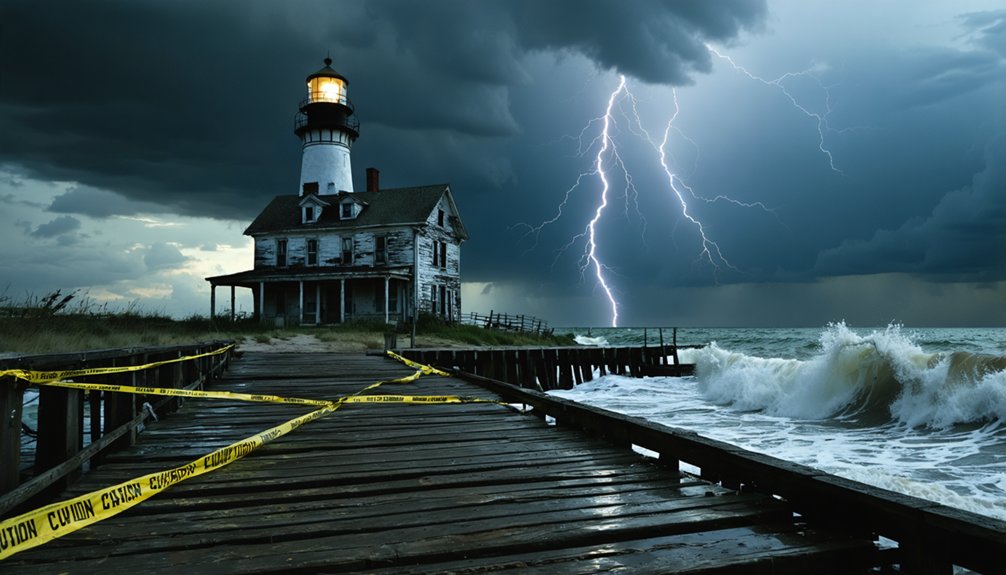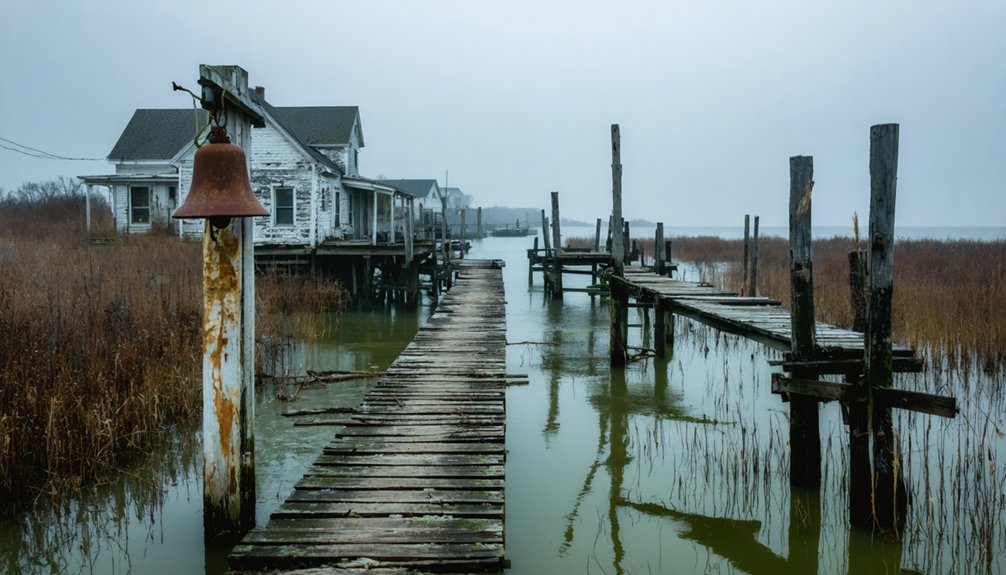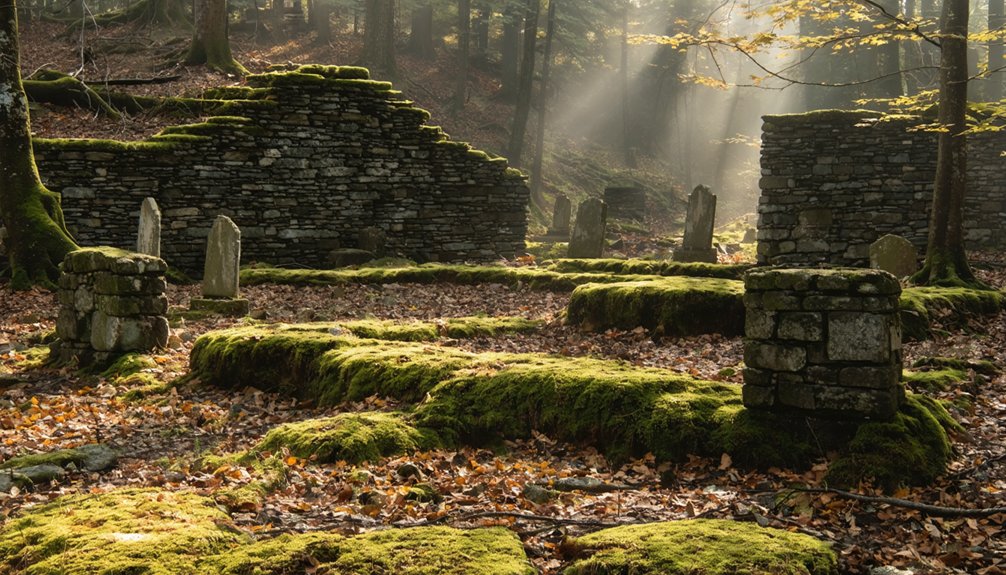You’ll find an intriguing coastal ghost town on Cuties Island in Connecticut’s Long Island Sound, featuring mysterious stone ruins dating back centuries. The island’s abandoned structures include 6th-century monk settlements and colonial-era foundations, with the largest ruin measuring 14 feet by 10 feet. You can only access the site by kayak or private boat from nearby Stamford marinas. While the island’s rich history spans indigenous peoples to 20th-century owners, its untouched landscape holds countless secrets waiting to be uncovered.
Key Takeaways
- Cuties Island features mysterious stone ruins of unknown origin, with structures up to 14 feet long scattered across Northern and Southern complexes.
- The island’s only permanent structure, Smart’s cottage built in 1945, burned down in 1959, leaving stone foundations.
- Access to this coastal ghost town requires kayak or private boat from Long Island Sound, with best landing at north shore.
- Ancient stone buildings and cottage ruins remain largely untouched since 1965, preserving the island’s abandoned character.
- The site is protected against vandalism, featuring colonial-era structures and possible early Christian influences through Chi-Rho petroglyphs.
The Mystery of the Stone Ruins
While archaeologists continue to debate the true origins of Cuties Island’s stone ruins, these mysterious structures have spawned multiple competing theories spanning over a millennium of possible construction dates.
Located in Connecticut, the site is divided into distinct Northern and Southern Complexes, each featuring impressive stone structures amid cliffs and swamps.
You’ll find evidence pointing to various builders, from 6th-century Irish monks fleeing persecution to colonial settlers and Native Americans.
The archaeological significance of these ruins is highlighted by their impressive dimensions – the largest structure measures 14 feet long, 10 feet wide, and 6.5 feet high, mirroring Irish monastic oratories. Several distinctive Chi-Rho petroglyphs discovered at the site suggest potential early Christian influences.
Carbon-14 dating has revealed stone origins exceeding 1,000 years, suggesting pre-Colonial construction. A 1654 letter mentions “stone walls and strong forts,” while wear patterns on stone circles indicate practical uses like bark processing.
Though exotic theories of Viking or Phoenician builders exist, they lack solid archaeological support.
Getting to the Abandoned Island
Situated off the coast of Stamford in Fairfield County, Connecticut, Cuties Island can be reached primarily by kayak or private boat through the waters of Long Island Sound.
You’ll find several boat rentals in Stamford’s marinas, but be prepared to navigate carefully around the island’s contrasting shores – a clear-water beach on the north and treacherous rocky terrain on the south. Once a thriving residence, the island now contains only stone fireplaces and remnants from the original cottage that burned down in 1959.
- Launch from nearby Cove Island Park or Cummings Park, where you’ll find ample parking and easy water access. For precise navigation, refer to the island’s UTM coordinates at 18T 625169.58681999 4543810.3327823.
- Check weather conditions and tides before departure – strong winds and currents can make kayaking challenging.
- Pack essential kayaking tips: wear a life jacket, bring navigation tools, and travel with companions for safety.
Remember to secure any necessary permits and respect local wildlife during your exploration of this abandoned isle.
A Brief Timeline of Ownership
Once you’ve navigated to Cuties Island’s shores, you’ll find yourself at a location with a fascinating ownership history spanning multiple centuries.
While the island’s indigenous heritage remains undocumented, its modern historical significance begins in 1945 when Paul Hurlburt Smart, a Darien lawyer, acquired the property and built the island’s first known permanent structure.
Smart’s cottage stood until 1959 when it burned down during his extended absence, leaving only stone foundations and fireplaces that you can still explore today.
Much like the Dark Entry Forest in Connecticut’s historic Dudleytown, the area has a mysterious and foreboding atmosphere that draws curious visitors.
In 1965, the Daddona family purchased the island, becoming its second documented private owners.
Since then, the island has remained largely untouched, with no new development or changes in ownership, preserving its wild character for adventurous visitors.
The island’s earliest recorded history traces back to when Charles Deal became its first owner in 1657.
Exploring the Coastal Ghost Town
Despite its small size, Cuties Island offers adventurous explorers a uniquely preserved coastal ghost town experience off Stamford’s shoreline.
Step back in time on tiny Cuties Island, where abandoned ruins and untamed shores create a haunting coastal retreat.
You’ll need a boat to access the island’s hidden treasures, with the north shore’s clear-water beach providing the safest landing spot. As you navigate through the overgrown landscape, you’ll encounter the ghostly remains of colonial-era stone buildings and a 1950s cottage foundation. Similar to Dark Entry Forest, the area is now strictly off-limits to protect against vandalism. Like Factory Hollow in 1830, many structures were destroyed by devastating fires.
- Best explore during summer months when weather conditions are ideal and island wildlife is most active
- Watch your footing on the treacherous south shore’s rocky terrain
- Plan your visit around high tide for easier boat access to the north beach
The island’s mysterious stone structures and untamed environment create an authentic ghost town atmosphere that’s rare among Connecticut’s coastal destinations.
Weather and Safety Considerations

While Cuties Island’s coastal location offers scenic exploration opportunities, visitors must carefully consider weather patterns and safety risks before starting their adventure.
Current conditions show 54 degrees Fahrenheit in the region, typical for Connecticut’s variable climate. You’ll encounter a humid continental climate with seasonal hazards ranging from summer thunderstorms to winter ice. With showers and thunderstorms common in the area, conditions can change rapidly. Temperatures swing from freezing winters to humid 80°F summers, with precipitation possible year-round.
Your climate preparation should include layered clothing, waterproof gear, and emergency supplies. Bring navigation tools, as fog and storms can quickly reduce visibility.
Watch for hazardous terrain, especially when wet or icy, and stay alert for coastal erosion. You’re responsible for checking weather forecasts and informing others of your plans, as the island’s remote location can delay emergency response.
Don’t venture out during severe weather or without proper safety equipment.
Frequently Asked Questions
Are There Any Reported Wildlife Species Living on the Island?
You’ll find extensive wildlife sightings including white-tailed deer, raccoons, eastern cottontails, various bird species, and marine life, reflecting the island’s rich species diversity in its undisturbed habitats.
What Happened to Paul Smart After the Cottage Burned Down?
Like a fading shadow, Paul Smart’s life after the cottage fire remains largely undocumented. You’ll find he kept ownership until 1965, then returned to Darien, Connecticut, where he lived until his 1979 death.
Has Anyone Attempted to Restore or Develop the Island Recently?
You won’t find any recent developments or restoration efforts since the area’s private ownership strictly limits access. Conservation priorities have kept the island focused on forest preservation rather than redevelopment projects.
Are There Any Underwater Archaeological Findings Near the Island?
Picture a sunken world beneath the waves. You’ll find no documented underwater discoveries or archaeological surveys specifically near this island, though Long Island Sound holds numerous unexplored shipwrecks in its depths.
Does Local Law Enforcement Monitor or Restrict Access to the Island?
You won’t find active law enforcement policies or island access regulations. There’s no documented monitoring, posted restrictions, or regular patrols controlling your visits to this remote, legally ambiguous location.
References
- https://usghostadventures.com/haunted-stories/americas-most-haunted-east/the-curse-of-dudleytown/
- https://www.cthauntedhouses.com/blog/real-haunted-places-cts-most-notorious-ghosts-call-home.html
- https://www.ghosttowns.com/states/ct/cutiesisland.html
- https://en.wikipedia.org/wiki/Cuties_Island
- https://www.ctinsider.com/projects/guides/urban-legends-connecticut/
- https://www.youtube.com/watch?v=6P8dZZ8t0x0&vl=fr
- https://www.ctpost.com/news/article/An-island-off-of-Milford-supposedly-among-the-6691608.php
- https://i95rock.com/exploring-haunted-places-connecticut/
- https://www.irishcentral.com/roots/history/irish-monks-ancient-stone-structures-connecticut
- https://www.ancient-origins.net/ancient-places-americas/gungywamp-0016030



